Is it possible to replant the plum in the fall? Planting and pruning plums in autumn and spring
Planting trees is a necessary and important procedure. Very often, for this, it is necessary to re-plan the dacha plot and move the plantations in order to free up space for the construction process.
Often, a tree is required not only to be transplanted from one place to another, but also to be transported from one garden to another. One way or another, the issue of transplanting a plum tree with minimal injuries to the roots remains relevant among gardeners.
First, you need to decide on the most favorable time to move the plum tree. This process is optimally carried out before the onset of intensive plant development. In other words, the season of spring April or autumn October is best suited for such a task. In the second case, the specific time possible for replanting plums is until the twentieth of October. Then there will be a little less than thirty days before the first frost.

Secondly, many are interested in the question, is it possible to replant a plum tree in the month of May? Although trees can be transplanted in late spring or summer, this can only be done in the most extreme cases. In addition, if the transplant occurred during this period, then this year you can not rely on the fruits, and if the roots were damaged, then the break will be delayed for two years.
The best tolerated transplant trees, whose age has not yet reached four years. One or two year old saplings take root in any soil. As for old trees, their roots are branched in character, but, moreover, small new roots gradually grow in the root system. It is for this reason that old trees take root for a long time and poorly, changing their location. To speed up the process of adaptation of the tree in the new conditions, you need to transplant it along with a piece of land from the old place. Also, this condition will help to preserve a larger number of roots.
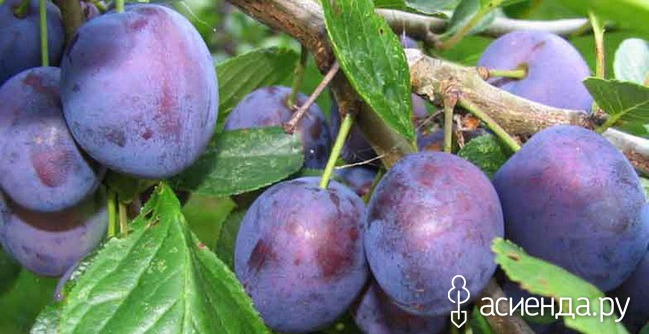
Often, among summer residents, another interesting question arises - is there an opportunity to transplant plum trees? The answer is actually quite simple: if the tree is grafted, then there is no point in moving the young shoots from the roots. The fruits in this situation will be small, and the taste will begin to sour. But in the situation when the question arises about high-grade trees with large fruits, then the processes can be separated from the roots and planted in a new location.
The process of transplanting begins with the preparation of a place for a new tree. In the autumn time, the pits for the root system of the tree are prepared in about twenty days. But if the transplant is planned for spring, then the pits must be created already in the autumn season. Dimensions of the pit must also meet certain standards. So its width will be approximately 80 centimeters more than an earthen coma. More precisely, to plant a two-year tree, fit a hole with a size of 70 to 70 centimeters. The same should be its depth. After all this, a drainage layer is placed at the bottom of the recess. As it is used well expanded clay or brick. Such material well protects the root system from moisture stagnation. This is especially true when the groundwater at the dacha is close to the surface. The next step is to put a layer of compost into the pit and a layer of earth on top of it. This will help the roots to avoid direct contact with the fertilizer.
Remove the seedling from the ground also need to correctly and correctly. In carrying out this process, you need to initially pour about five buckets of water, and then dig around the tree around the circumference. After this, it is necessary to cut an earthen clod in the shape of a cone, the depth of which will be approximately seventy centimeters. Then you can gently pull out a sapling.
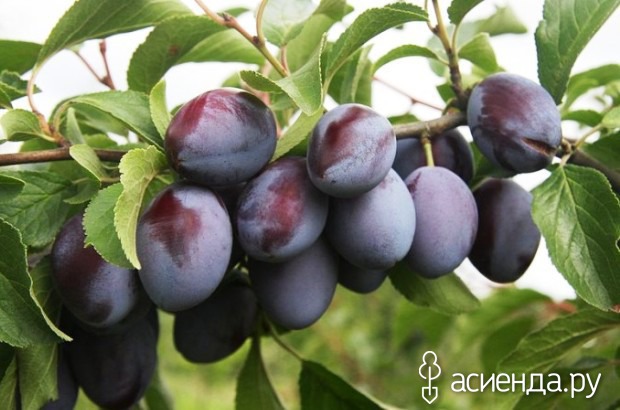
After transplantation, it is worth taking care of the care of the plum tree, so that it quickly settles in a new place and gives fruit. Undoubtedly, the conditions for the development of plums should be as comfortable as possible. This tree loves heat and moisture. Therefore, if you plant a tree in the shady part of the garden, its yield will decrease several times. An important role is also played by the soil composition. Dense soil will not be the best solution for the active growth of plums. In such a soil moisture stagnates, not allowing to penetrate into the roots of a tree. It is better to choose a place with loose soil, where the sun falls, warming the ground.
Worthy yields to you!
Transplanting plum in the fallwill enable the root system to take root successfully in a new place. Next spring, the young plum will develop effectively, which will ensure a good harvest of fruits in a short time. Agrotechnics recommend using for transplanting plum saplings no older than five years.
Terms of plum transplanting in the fall
When is it best to replant the plum in the fall? Plums transplanted in the second half of the autumn period. In October, the air was already cooled, and the ground was not frozen. A new tree will avoid the danger of sprouting shoots that can be destroyed by frost. And be able to take root in the warm enough for this land.
Preparing for a transplant
Plum saplings are prepared for transplantation as follows:
- Watering. Under the drain poured up to five buckets of water.
- Digging Plum digging, digging around the trunk. At the same time, seventy centimeters recede. And cut a cone-shaped piece of land, plunging into the depth of the same seventy centimeters.
- Transportation. Plums with earthen cones are separated from the ground, trying to keep the clod around the roots intact. The bottom of the plum is wrapped with a film or bag, tied with wire (rope). Packed seedlings are delivered to the transplant site.
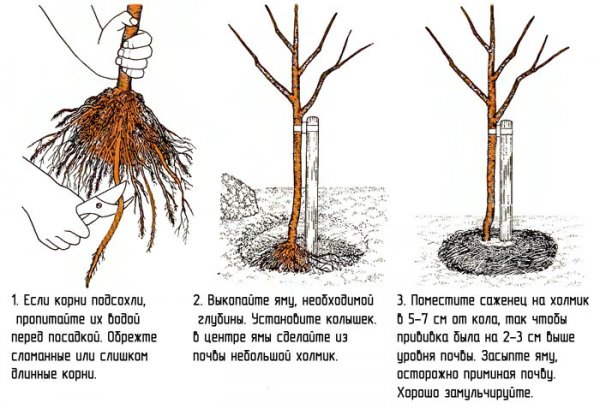
How to transplant the plum in the fall
Technically, plum transplantation is simple:
- Pit parameters. The size of the pit should be a few tens of centimeters wider and deeper than the earthen cone around the roots of the plum.
- Top dressing. The bottom of the pit is filled with compost.
- Installation Plum is lowered into the pit, setting so that the area of the "root collar", the space between the root and the trunk, is at ground level.
- Backfilling. Plums fall asleep, filling the hole completely. Simultaneously with backfilling it is watered until the soil is moistened.
- Wind protection Thin plum strengthen, tying to a strong Coke.
- Mulching. Place under the plum sprinkled with soil and cover with a layer of ash mixed with peat or sawdust.
Plum is one of the most famous fruit crops. It came from Asia and spread throughout Europe, not forgetting Russia. This shrub is quite unpretentious and easy to take root. on the suburban areas, but a good harvest should be counted only with proper care and proper planting.
The main rule of any planting or replanting a tree - it must have time to settle down before the onset of heat or cold, otherwise the whole year will be wasted.
In other words, it is necessary to plant and replant the plum:
- In early spring: it is necessary to plant before the start of sap flow and the appearance of buds, that is, already in April, as soon as the earth warms up. In this case, the drain will immediately begin to actively develop and feed, which will give her the opportunity to get stronger until the next wintering. Also, the advantages of a spring transplant should include the time: if the gardener is slightly delayed in planting, he will not have to worry about the health of the seedling.
- In the first half of autumn, from the end of September to the 20th of October. It is important to have time to transplant 3-4 weeks before the onset of cold weather, otherwise the plant will freeze. Transplantation in the fall helps to fully prepare the garden for the next year.
Plum transplantation in May is possible, but undesirable: the tree will not have time to gain strength and is unlikely to give fruit in the first year. Sometimes rooting may take two years.
The timing of the transplant is also influenced by the selected grade.: for example, winter-hardy varieties can be planted immediately after the snow melts.
Equally important terrain: for the Moscow region and the Central zone are the terms of transplantation described above. In Siberia and the Urals, it is worth doing the autumn transplant a little earlier, when it remains about a month before the frost, it is also necessary to dwell on specially bred varieties.
Advantages and disadvantages of the fall landing
Transplanting plums in the fall has several advantages:
- The opportunity not to lose the year if the tree does not take root. If during the fall transplant the plum cannot settle down or suffers, in the spring the bush can be replaced with a new one without spending a whole year.
- No need to rush in the spring. In the spring it is important to have time to plant the plum before it starts to develop buds, but the earth does not always have time to warm up, and you should not forget about the night frosts.
- In the autumn, transplantation can be combined with other agricultural works, without wasting time.
- Plum will receive a double "portion" of fertilizers - in the fall during transplanting and in spring.
- Having transplanted the plum in autumn, in the spring the bush will start to grow immediately, which will allow it to grow faster.
The disadvantages of the autumn works include lack of ability to trace the plant. If in the spring the gardener appears regularly at the dacha and immediately draws attention to the problem, in winter the tree will have to wait until the very thaw.
Also, in some regions, winters are characterized by an unpredictable nature (they may be too hot or, on the contrary, warm), which also affects the characteristics of transplanting and growing.
Choosing time for transplant, it is important to focus on your own comfort and climate. For example, if winter is not consistent, and seedlings often die due to temperature fluctuations, it is worth planting them in spring.
Basic landing rules
Before you start transplanting, remember some important rules:
- you can replant only young trees, not older than 2-3 years. At an older age, the plant already develops a huge root system, due to which transplantation will be difficult;
- when digging it is important not to damage the roots, otherwise the bush will need an additional year to restore the system. It is best to perform a transplant without cleansing the roots;
- when transporting plants from one place to another, it is important to carefully handle the roots;
- when planting plums in the spring, it is necessary to prepare the pits in the fall, while in the autumn, 2-3 weeks before they start.
Step-by-step guide on planting in open ground, growing and care
Successful transplantation depends on several factors, we have prepared for you a step-by-step guide on planting and caring for a garden plum seedling.
Seedlings training: it occurs in three stages. First, you need to water the bush plentifully to make it easier to dig. To do this, pour 4-5 buckets of plain water on plum roots.
Then you need to dig a tree in a circle at a distance of 70 cm from the trunk, dig a cone-shaped piece with the roots and carefully pull out the plant, trying not to damage the roots.
If the tree needs to be transported, its roots should be wrapped with a bag or film, securing it with a rope.

Choosing a place: plum likes a sunny warm place with protection from the wind, without excess water and without stagnant melt water. Best of all, the plant survives on moderately moist and fertile soils, clay soil does not suit him.
Other large crops should not grow close to the shrub, otherwise they will drag all nutrients from the plum and create shade.
Planting in open ground: The first thing is to prepare the ground in advance. With an autumn transplant, this is done in 2-3 weeks, that is, at the beginning of autumn.
It is necessary to dig pits 70cm * 70cm * 70cm at a distance from each other. Then pour a layer of drainage (broken brick or stone) - this will help remove moisture stagnation.
After you need to pour a layer of compost and cover it with a thin layer of earth - this will save the roots from excessively strong action of fertilizers. The remaining earth is mixed in equal proportions with the humus, add 300 grams of wood ash and fall asleep in the pit.
When planting, dig a hole in the ground and carefully carry a bush there, straightening the roots. Then the seedling is watered abundantly, and the ground is mulched.
When planting it is necessary to ensure that the root neck is 3-5 cm higher than the ground level.

Aftercare: the first 2-3 years, the main care of the plum will be in its growth and the formation of the crown.
To do this, you need to regularly take care of, remove the lower branches, shorten unnecessarily long and thicken the crown. It is important to do this while the branches are young, then pruning will be painless.
Plum requires regular watering (about 5 buckets of water under each tree), loosening the soil and removing weeds. With a bountiful harvest, it is necessary to provide branches with supports so that they will not break.
In the first year after planting, the plant will have enough fertilizer already in the pit, then you have to feed it.
In the spring as a complementary food, you can use a solution of bird droppings or cowshed, also suitable nitrogen fertilizers. In the autumn It is necessary to make superphosphate or potassium sulfate - 100 grams per plum.
Proper preparation for winter
Winter preparations must begin. a few weeks before the cold. Fertilizers must be applied for each drain: a bucket of humus, 200-300 grams of ash and 30 grams of potassium sulphate or superphosphate will be required per square meter of land.
Fertilizers need to be slightly dug, loosening the ground, and plenty of water.
Then need inspect the crown and trunk, removing all pests. The spoiled leaves and branches are cut and burned away from the trees, the tainted bark is scraped off with a scraper and a metal brush.
In the process, you need to be careful not to hurt healthy areas.
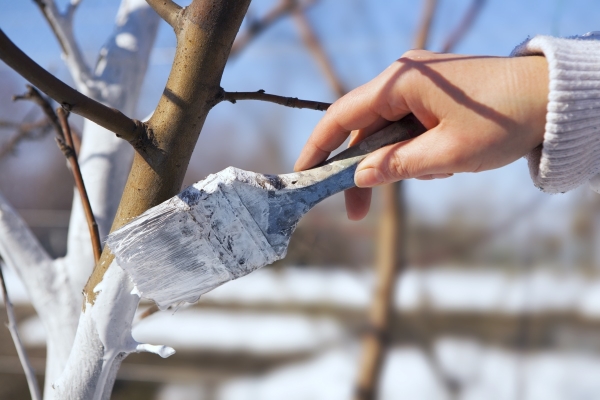
After leaf fall for insect protection the barrel is whitened with a special solution from the store or a mixture of equal parts of lime, clay and cowshed. You can also add copper sulphate - 30 grams per liter of whitewash.
Just before the frosts trunk warmed with sacking or straw. If winter promises to be cold, you can use slate or roofing felt. If the bushes are still small, you can cover them with a bag or spruce branches, make a “hut” of the boards.
Any “shelter” should be carefully secured so that the wind does not blow it away. Soil under the tree spud and spread with manure.
Is it possible and how to replant the plum in the fall?
It is possible to replant only young trees, up to 4-5 years old. Older trees have too developed roots, which makes it extremely difficult to dig them out without damage.
Wherein plum extremely sensitive to any wounds and because of this, it will take longer to take root in a new place.
When transporting you need to follow the branches and roots: the first can be carefully tied with a rope, the second - to wrap a bag. The rest of the transplant occurs as described above.
At first glance, the drain may seem rather capricious and difficult to maintain, but this is not true. Careful and careful care is mainly required young seedlingsthat are just starting to grow.
A few years later formed tree will require a minimum of effort - watering, feeding and insulation for the winter.
Home plum - fruit tree, which came to us from Asia and spread throughout the world. Despite the fact that the culture is quite unpretentious, without proper care it will be poorly fruited or not fruitful at all. The main measure of plum care is pruning. And also important is the way of planting and caring for her.
We will understand how and when it is better to plant a plum, how to care for it and cut it off.
The main rule in planting and transplanting any fruit tree is to have time to plant it before the onset of cold weather or heat. The best time for this is early spring or early autumn.
When to plant
How to plant a plum in the spring? Spring planting is carried out in April, before the onset of sap flow and the formation of buds. In this case, after planting, the tree will immediately begin to actively feed and grow. If the gardener will delay with landing until May, do not worry. In this case, the plum is unlikely to give fruit in the first year, but for her health will not have to worry.
How to plant a plum in the fall? Autumn planting should be carried out in late September or early October. It is important to plant a tree 3-4 weeks before the onset of cold weather, otherwise the plant will freeze. The advantage of the autumn planting before the spring is the possibility not to lose a whole year if the tree takes a bad root. In this case, the plant can be changed to another.
How to plant
The basic rules for planting a home plum are as follows:

Planting garden plum held in several stages. First you need to prepare the seedlings for planting. In order to make a tree easier to dig, you need to pour it abundantly. Four to five buckets of water for each plant will be enough. Then you need to gently dig around the plant at a distance of about 70 centimeters. From the ground you need to dig up the roots with a clod of soil. If the tree needs to be transported, wrap the roots in plastic film or put it in a plastic bag.
Next, you need to decide on the choice of location for the plum tree. Plum prefers fertile soil, clay does not suit it. As for the location, the best option for plum is a sunny, warm place where melted water does not stagnate and there is protection from strong winds. If other fruit trees or large shrubs grow next to the plum, there will be little nutrients left for plum. Therefore, it is better to plant a tree away from others. The minimum distance between cultures is 3 meters.
For transplanting in open ground need to prepare well in advance. Two or three weeks before the autumn planting, dig a hole 70x70x70 in size. For spring planting, the pits are dug out since the fall. Before planting at the bottom of the pit, put the drainage - this will help the moisture to go into the ground, not stagnant at the roots. Then in the pit you need to put a layer of compost and sprinkle with soil. Shrub to carry carefully, straightening the roots. Pour the rest of the pit with a mixture of soil and humus in equal proportions and wood ash (about 300 grams). After planting, the sapling is plentifully watered and mulched.
Watering
The basis of the care of plum trees is their watering. Home plum does not like drought, so in particularly dry periods it needs to be watered abundantly. This is especially true of young trees. Measures of watering: under a young tree 5 buckets of water, under a ripe fruit bearing - 10 buckets of water. Pristvolny circle can be mulched with humus or compost. Manure is not recommended for this purpose.
Top dressing plums
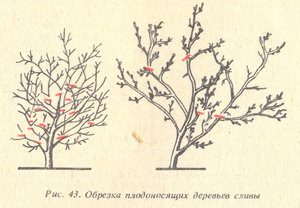 Autumn and spring plum needs feeding. However, if the necessary fertilizers were applied during planting, then there is no need to feed the plums for the first three years. It will be enough to add urea solution to the plant every spring.
Autumn and spring plum needs feeding. However, if the necessary fertilizers were applied during planting, then there is no need to feed the plums for the first three years. It will be enough to add urea solution to the plant every spring.
After three years of growth, you can supply the plant with organic matter. This is done in the autumn period. First you need to grouch the earth around the tree and add 10 kilograms of compost or manure. Fertilizer should be mixed with the soil at a depth of about 20-30 centimeters.
Mature plum trees 6–8 years old fertilize in the same way. Only if top dressing for young trees was brought in a ring around the trunk with a small indentation, then the mature plant fertilizes directly under the trunk. Pure manure is not recommended because it can burn a delicate tree trunk. It is better to mix it with compost in proportions 1: 1.
Preparing for the winter
Preparing for winter should be carried out in a timely manner: a few weeks before the onset of cold weather. This includes autumn dressing of the plant, as well as autumn pruning (the nuances of pruning will be discussed below). The trunk and branches should be examined for the presence of pests, cut off and burn the diseased branches.
To protect the trunk of the fruit tree from insects, use whitewash. You can purchase a special tool in the store, and you can make it yourself. You will need lime, mullein and clay. Ingredients must be mixed in equal proportions and whiten the stem with the resulting mixture.
Before frost, young trees are warmed. The barrel can be wrapped with burlap or straw. In case of waiting for stronger frosts, you can use roofing felt or slate. Small trees can be covered with a tent made of fir branches or boards. Any shelter must be securely fastened.
Pruning Pruning
Care of the plum in the spring and autumn is impossible without proper pruning. Before giving information about the rules of pruning, let's see why it is needed. Some gardeners do not carry out this procedure, which leads to a decrease in the degree of winter resistance of trees, the neglect of the crown and the shredding of fruits. The main objectives of trimming:
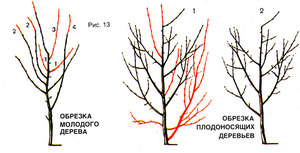
Pruning pruning carried out both in spring and autumn. Let us understand how these two methods differ and in what case this or that method should be applied.
Pruning spring plum
It is spring pruning that is preferable for plums, since in summer it is more likely to recover from cuts than in winter. Spend spring pruning immediately after planting the seedling. Plums grow quite quickly and need to form a crown. The best period for spring pruning is the beginning of summer or the end of spring. It is necessary to wait for the period when the temperature at night will not fall below zero. Then the chance that the tree will quickly recover from pruning is very large.
Scheme of spring pruning plums by year
In the first year after planting a tree in open ground, it must be cut. Annual seedlings should be shortened from above with a sharp knife at a height of not more than 60 centimeters from the ground. The root system of the tree is quite strong, so it quickly takes root and takes root. In the first year of plum growth, it is necessary to monitor the correct growth of the twigs. Branches that take the wrong direction will need to be removed.
In the second year The tree is cut to 40 centimeters above, removing the upper bud under the cut. The side guide branches are pruned in the same way. Lower shoots need to be shortened to 7 centimeters. These branches are auxiliary and will not bear fruit. After the second year of vegetation, they need to be removed altogether.
For the third year you must select seven or eight strong, properly growing side branches, and remove the rest in the same manner as described above.
All subsequent years pruning should be reduced to thinning the crown. It is necessary to monitor not only the thickening of the crown, but also the formation of forks, which should not be allowed.
Pruning in the fall
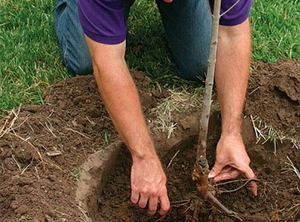 Despite the fact that most gardeners agree that prunes are pruned only in spring, many still carry out the procedure in autumn. Autumn pruning is usually done in Septemberwhen the leaf has already passed. At this time, the vegetation period ended and the tree is ready for the procedure. The wounds after pruning should have time to heal by the winter, which is why it is not necessary to tighten the autumn pruning.
Despite the fact that most gardeners agree that prunes are pruned only in spring, many still carry out the procedure in autumn. Autumn pruning is usually done in Septemberwhen the leaf has already passed. At this time, the vegetation period ended and the tree is ready for the procedure. The wounds after pruning should have time to heal by the winter, which is why it is not necessary to tighten the autumn pruning.
It is necessary to remove all dead, dry and disease-infected branches, shorten the tops. Fast-growing shoots must also be shortened. Branches that thicken the crown should be shortened by about 30%. Cut branches are recommended to be burned so that diseases do not spread throughout the garden.
Grafting plum
Grafting, as opposed to feeding, trimming and watering, is an additional measure. . The main functions of this procedure:
- rejuvenation of old wood;
- obtaining a new variety with other qualities of fruits;
- yield increase.
The best time for a scion is spring, because sap flow begins at this time and the grafts are grafted better. In the autumn and summer, it is also possible to vaccinate, if there is enough time before the frost.
As for the choice of stock, everything is simple. The ideal vaccination option - plum on plum. Thus, you can cross different types of plums and get an interesting harvest. If there are no free plums in the garden, cherry plum, apricot or felt cherry will do.
So, plum care is not a complicated procedure and does not take much time. However, if you follow all the recommendations and give your tree minimal attention, it will delight you with large and tasty fruits for many years.
Attention, only TODAY!
Plum - moisture-loving tree; loves bright lighting and protection from the north winds; does not like the soil with high groundwater. The roots are horizontal, growing at a depth of 20-50 cm, only a few go to great depths. In adult plums, the roots extend 1–1.5 m beyond the perimeter of the crown — this must be taken into account when transplanting: digging damages most of the root system. This leads to homozy - a disease when cracks with expiring gum (resin) form on the trunk. Transplanted plums older than 4 to 5 years old do not survive well and are ill for a long time, so it is not advisable to move them.
The optimal time for plum transplantation is early spring, when the buds have not yet begun to swell, or autumn, from mid-September to October 20 (for central Russia, in other regions, the transplant dates are shifted according to climatic conditions).
Planting pits for spring planting are prepared in autumn, for autumn plant - 15 to 20 days before work. The size of the pit - 60 - 80 cm larger than the root ball of the tree. For a 2-year-old sapling a pit of 70x70x70 cm of any shape is sufficient. When digging, the upper layer of the earth is cast aside; the bottom of the pit loosened on the bayonet.
With close occurrence of groundwater at the bottom of the pit, drainage is made of broken bricks, expanded clay, and stones. Then pour the top layer of soil, 1 - 2 buckets of humus, 1 kg of ash, all mixed and poured two buckets of water.
Sometimes transplanted to a new place grown up undergrowth. If an adult tree was grafted, then the works will not be justified: the berries on the sapling can be small and sour. But if the mother tree was also grown from overgrowth, and the quality of its fruit is decent, then it makes sense to dig out a sapling. In dry weather, its near-stem circle is well watered, dug at a distance of 40 cm from the trunk, trying to damage the roots as little as possible. The excavated seedling is placed on the cellophane by its roots and is well packaged if transportation is required.
It is best to buy in the nursery an annual sapling with a closed root system. But seedlings and with an open root system take root pretty well, if their roots were carefully packed and not dried. Before planting, their roots must be carefully inspected: rotted and diseased roots cut off. For some time, the seedling can be placed in a bucket of water.
When transplanting a plum tree with an open root system, the ground is poured into the hole to create a small cone in the middle. In the middle of the pit drive a stake; on the north side of it is placed a sapling. It is more convenient to carry out the work together, so that one person would hold the sapling, and the second could gently spread his roots along the surface of the earth cone, so that they would not be bent, and fall asleep with soil. Plum root neck should be 5 - 7 cm above the top edge of the pit. While planting the soil, the seedling is shaken lightly so that all the gaps between the roots are filled. The land is carefully protected: at the edges of the pit - denser, at the trunk - easier.
When a specimen with a closed root system is transplanted, peat, humus, fertilizer and fertile soil are poured on the bottom of the pit, on top of the drainage. Everything is mixed, rammed and watered. From above establish a sapling in such a way that the root neck is slightly above the soil surface. The gaps between the edges of the pit and the earthy clod are covered with fertile soil and trampled. A peg is driven in along the edge of the pit.
A seedling is wrapped in a string, overlapped with an eight and tied to a peg. Along the edges of the landing pit make a hole and pour into it 1 - 2 buckets of water from the "Kornevin". Pristal circle is covered with a thick layer of humus or peat. After transplantation, the plum is watered weekly with fertilizers that stimulate rooting. In spring, the seedling is cut to a height of 1.5 meters. To plum abundantly fruited, at least two trees are planted at the same time.
Plums of 4 - 5 years a year before transplanting 70 cm from the trunk, in a circle, they dig in a groove 50 cm deep; the roots are cut off. The groove is filled with humus, sand, peat with the addition of ash; compacted and plentifully watered. During the summer, watered several times; a lot of suction roots grow on the trimmed roots.
A year later, the plum is again dug around the outer edge of a previously dug groove, trying to preserve the young roots. Gradually deepened, chopping the remaining roots and forming an earthen clod with a thickness of 70 cm. The tree is tilted and sackcloth is brought under it, then it is rolled over onto the underlying material. The roots are wrapped so that the earth does not crumble.
Before planting, measure the depth of the landing pit to match the thickness of the root ball. Drain in a hole can be lowered straight from the jute sacking - in the ground it will gradually decompose. The pit is filled up with soil, and 3–4 cokes are driven in and driven into it, to which a plum is attached to the stretch marks. The trunks and bases of the skeletal branches are wrapped in moss or sacking, which are moistened with water for 2–3 weeks. The transplanted tree is regularly watered with "root". In the spring, the conductor is trimmed to a third of the length and 2 to 3-year increments. With good care, plum can begin to bear fruit the next year.

